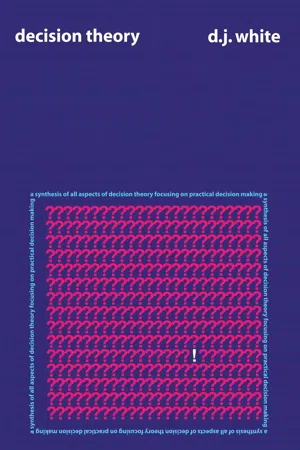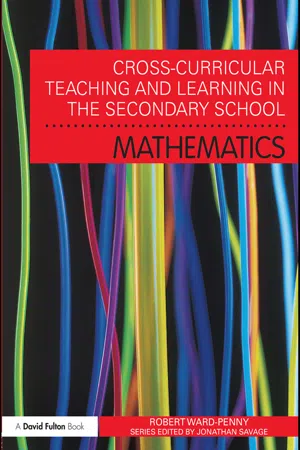Decision Maths
Decision Maths is a branch of mathematics that focuses on solving real-world problems using algorithms and decision-making techniques. It involves modeling and analyzing decision processes to optimize outcomes in areas such as logistics, network design, and resource allocation. Decision Maths often utilizes graph theory, linear programming, and game theory to provide solutions for complex decision-making scenarios.
4 Key excerpts on "Decision Maths"
- eBook - ePub
- D.J. White(Author)
- 2018(Publication Date)
- Routledge(Publisher)
...CHAPTER 7 Mathematical Models and Decision From our point of view any model which can add any decidability content to selection processes comes within the area of mathematical models. Thus, for example, as is the case in queueing theory, any analysis which allows one to deduce the probabilities of certain events from other probabilities is allowable, even though this may not be carried any further in the analysis of the final selection. We would include simulation studies because they analyze the effect of various decision rules even though the final choice may be left to the person himself without any prior analysis of his values. The simulation procedure is simply a physical means of solving a given mathematical problem, which has first of all to be developed from the real system before simulation can be carried out. It will not be the purpose of this report to give a detailed coverage of the mathematical models involved. These can be found in the appropriate references. The purpose is simply to ascertain the manner in which decision is introduced into selective processes by the use of mathematical models. The essential mathematical content of our analysis lies in the manner in which the mathematical model, once derived, is processed to get the solution. We have mentioned simulation. However, the real power of mathematics lies in the ability to derive computational algorithms for characteristic models, which are as effective as possible. These algorithms effectively allow many more alternatives to be considered than would be possible by direct enumeration in the absence of a mathematical model. Optimization is always relative to the problem specified. Thus, although there may exist alternatives which are better than the one eventually selected, this does not invalidate its optimality relative to the initial problem. If higher level optima are required then their attainment must be allowed for in the original problem...
- Anindya Ghosh, Prithwiraj Mal, Abhijit Majumdar(Authors)
- 2019(Publication Date)
- CRC Press(Publisher)
...1Introduction to Decision-Making and Optimization Techniques1.1 IntroductionDecision-making is the art and science of choosing the best course of action or a set of preferred actions from the available alternatives. Decision-making involves assumptions, information, emotion, communication, and computation. In an organization, decisions are taken at three levels, namely, operational, tactical, and strategic. Operational decisions are taken at the lower-level management based on structured information, and these decisions have short-term impact. Strategic decisions, which involve unstructured information, are taken by the top management, and they have long-term implications. Tactical decisions are taken by the middle management. All of these decisions are taken after considering information related to political, economic, social, and technological (PEST) environments.Optimization, which is often used as a tool for decision-making, is one of the most exciting branches of applied mathematics. There is hardly any area in science and engineering where optimization has not made itself useful. The great scientist E. Euler once quoted, “Nothing takes place in the world whose meaning is not that of some maximum or minimum.” With the advent of high-speed computers, optimization algorithms are becoming increasingly popular in science and engineering. Over the last few decades, the introduction of a number of nontraditional optimization algorithms inspired by natural phenomena has added a new dimension to the field of optimization.1.2 Decision-Making Process and ClassificationThe process of decision-making is shown inFigure 1.1. It is a sequential process, and the individual steps should not be considered in isolation. Decision-making becomes simple if only one alternative is available as there isnothing to choose, or if one alternative dominates all others in every criterion...
- Robert Ward-Penny, Jonathan Savage(Authors)
- 2010(Publication Date)
- Routledge(Publisher)
...In retail, for example, mathematical models based around probability are used to determine the quantities of stock that should be ordered to maximise profit; in finance models are used to calculate optimal rates of compound interest; and in manufacturing linear programming algorithms, similar to those taught in decision and discrete mathematics courses, are used to deduce how resources should be used to generate the largest profit. These models range from the simple to the complex, but they can be immensely important and widely recognised; the 1997 Nobel Prize in Economics was awarded to two economists, Robert Merton and Myron Scholes who, together with Fischer Black developed a model that described financial markets and derivative investment instruments. Modelling is a key part of mathematical literacy, and a skill which has relevance in many areas of the secondary curriculum. It is important, therefore, to provide pupils with a range of contexts within which to practice modelling, in order to enable them to be able to apply mathematics independently in the unknown contexts of the future. Modelling also offers pupils an opportunity to develop their communication skills, as pupils are forced to justify their assumptions and answers. In addition, detailed modelling in the classroom can require pupils to work collaboratively, just as it does in real business environments. Different members of the team bring different skills, knowledge and understandings that all influence the construction and refinement of the mathematical model. Mathematics in business studies and economics Whilst mathematical models play a key part in business studies and economics, these two subjects contain a number of other mathematical elements which also offer opportunities for cross-curricular links. Four of these are offered here as examples: Ratios are often used to assess and summarise the state of a business...
- eBook - ePub
It's All Analytics!
The Foundations of Al, Big Data and Data Science Landscape for Professionals in Healthcare, Business, and Government
- Scott Burk, Gary D. Miner(Authors)
- 2020(Publication Date)
- Productivity Press(Publisher)
...From our research, there is a bit of a divide with some camps calling it more behavioral, social and public policy oriented, and others calling it more business focused. Decision science is strongly aligned with analytics. From a view of academic programs (such as University of Pennsylvania and Harvard), decision science has strong roots and alliances in social and public policy and public health. On the business side, in an article in INFORMS Analytics Magazine (see Rajaram, 2018), Dhiraj Rajaram defines decision science as an overarching discipline above data science and that while data science problems are normally clearly defined, decision science problems are not: Decision science is the interdisciplinary application of business, math, technology, design thinking, and behavioral sciences to enable better decisions. Decision science enables addressing business problems that are ill defined and shifting and where the factors affecting the problem are not completely understood. It facilitates the design thinking paradigm: Taking business problems that start off as a hunch or as mysteries to becoming heuristic, rules, and judgment based, to becoming algorithm as one starts to see patterns, to becoming codified and tool-ified in parts before being operationalized in systems. Further it enables the on-going creation, translation, and consumption of data-driven insights to help organizations make better decisions. Decision science integrates and builds on data sciences by adding the aspects of business context, design thinking, and behavioral sciences. There are schools, such as Notre Dame, whose programs are more business oriented. One thing in common among the camps is that decision science includes the way we think, along with the way judgments and decisions are made...



